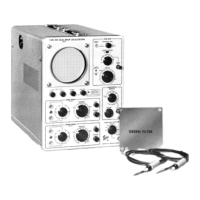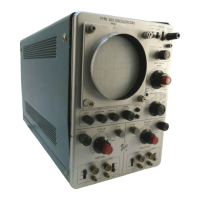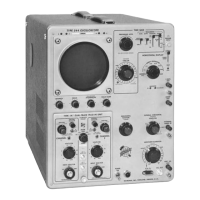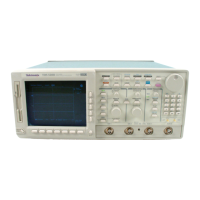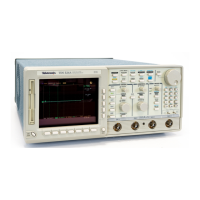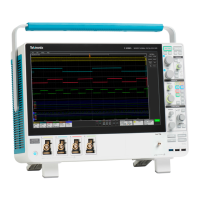5103N
SECTION
6
RACKMOUNTING
Change
information,
if any,
affecting this
section
will be
found
at
the
rear of the
manual.
Introduction
The
R5100-Series
Oscilloscope
is designed
for operation
in a
standard
19-inch
wide
rack
which
has
Universal,
EIA,
RETMA, or
Western
Electric
hole
spacing. When
properly
mounted,
this
instrument
will meet
all
electrical and envi-
ronmental
specifications
given in
Section 1
.
Instrument
Conversion
The
5100-Series
Oscilloscope
can
quickly be converted
from
a
bench
model to a
rackmount
model, or vice versa.
Field
conversion
kits,
including
the
necessary tools,
parts,
and
instructions
are
available
from
Tektronix, Inc.
Order:
040-0583-00,
Bench-to-rack
conversion;
040-0584-00,
Rack-to-bench
conversion.
Mounting
Method
This
instrument
will fit
most
19-inch
wide
racks whose
front and
rear holes
conform
to
Universal
hole spacing.
The
slide-out
tracks
easily
mount to
the
cabinet
rack front
and
rear
vertical
mounting
rails
if the
inside distance
between
the front
and rear
rails is
within
10-9/16
inches
to
24-3/8
inches.
If the
inside
distance
exceeds
24-3/8
inches, some
means
of
support is
required
for
the
rear ends
of the slide-
out
tracks (for
example,
make
extensions
for the
rear
mounting
brackets).
Rack
Dimensions
Height.
At least
5-1/4
inches
of
vertical space
is required
to
mount
this
instrument
in a
rack. If other
instruments
are
operated
in
the
rack, an
additional
1/4
inch is
required both
above
and
below the
R5100
to
allow space
for proper cir-
culation
of cooling
air.
Width. A
standard
19-inch
wide
rack
may
be used. The
dimension
of
opening
between the
front
rails
must be at
least
17-5/8
inches
for
a
cabinet in
which the front
lip of
the
stationary
section is
mounted
behind an
untapped front
rail as
shown in
Fig.
6-1
A.
If the
front
rails are
tapped,
and
the
stationary
section
is
mounted
in
front
of the
front rail
as
shown in
Fig.
6-2B,
the
dimension
between
the front
rails
should
be at
least
17-3/4
inches.
These
dimensions
allow room on
each
side
of the
instrument
for
the
slide-out
tracks to
operate so
the
instrument
can
move freely in
and
out
of
the
rack.
Depth.
For
proper
circulation
of cooling air,
allow at
least
two inches
clearance
behind the rear of
the instrument
and
any
enclosure
on the
rack. If it is
sometimes
necessary
or
desirable
to operate
the R5100
in the
fully extended
position,
use
cables that
are long
enough to reach
from the
signal source
to the
instrument.
Installing
the Slide-Out
Tracks
General
Information. The
slide-out tracks for the instru-
ment consist
of two assemblies, one
for the left side
of the
instrument
and one for the
right side. Each assembly con-
sists
of three sections. A
stationary section attaches to the
front
and rear rails
of the rack, the chassis section
attaches
to the
instrument (and is
installed at the factory), and the
intermediate section
fits between the other two sections
to
allow the instrument to
fully extend out of the
rack.
The
small hardware components
included with the
slide-
out track assemblies
are used to mount the
tracks
to
the
vertical rack rails having this
compatibility:
1.
Front
and rear
rail holes must be large
enough to
allow inserting a
10-32
screw through the rail mounting
hole if the rails are untapped (see
Fig.
6-1A).
2.
Or, front and rear rail
holes must be tapped to
accept
a
10-32
screw
if Fig.
6-1 B
mounting method is used.
Note
in
Fig.
6-1 B
right illustration
that
a #10
washer (not sup-
plied) may be added to
provide increased bearing
surface
for
the
slide-out
track stationary section front
flange.
3.
Front and rear rail
holes must be located on
Universal
spacing; that is,
the sequence for the hole spacing is 1/2
inch, 5/8 inch, 5/8
inch,
1/2 inch, etc.
Because of the
above compatibility, there
will
be
some
small parts
left over. The
stationary and
intermediate
sec-
tions
for both
sides
of
the
rack are
shipped
as a
matched
set
and should not
be
separated. The
matched
sets
of both
sides
including
hardware are
marked
351-0195-00
on
the
package. To
identify the
assemblies, note
that the
auto-
matic latch
and intermediate
section stop is
located
near
the top
of
the
matched set.
Mounting
Procedure. Use
the
following
procedure
to
mount both
sides.
See
Fig.
6-1
for
installation
details.
6-1

